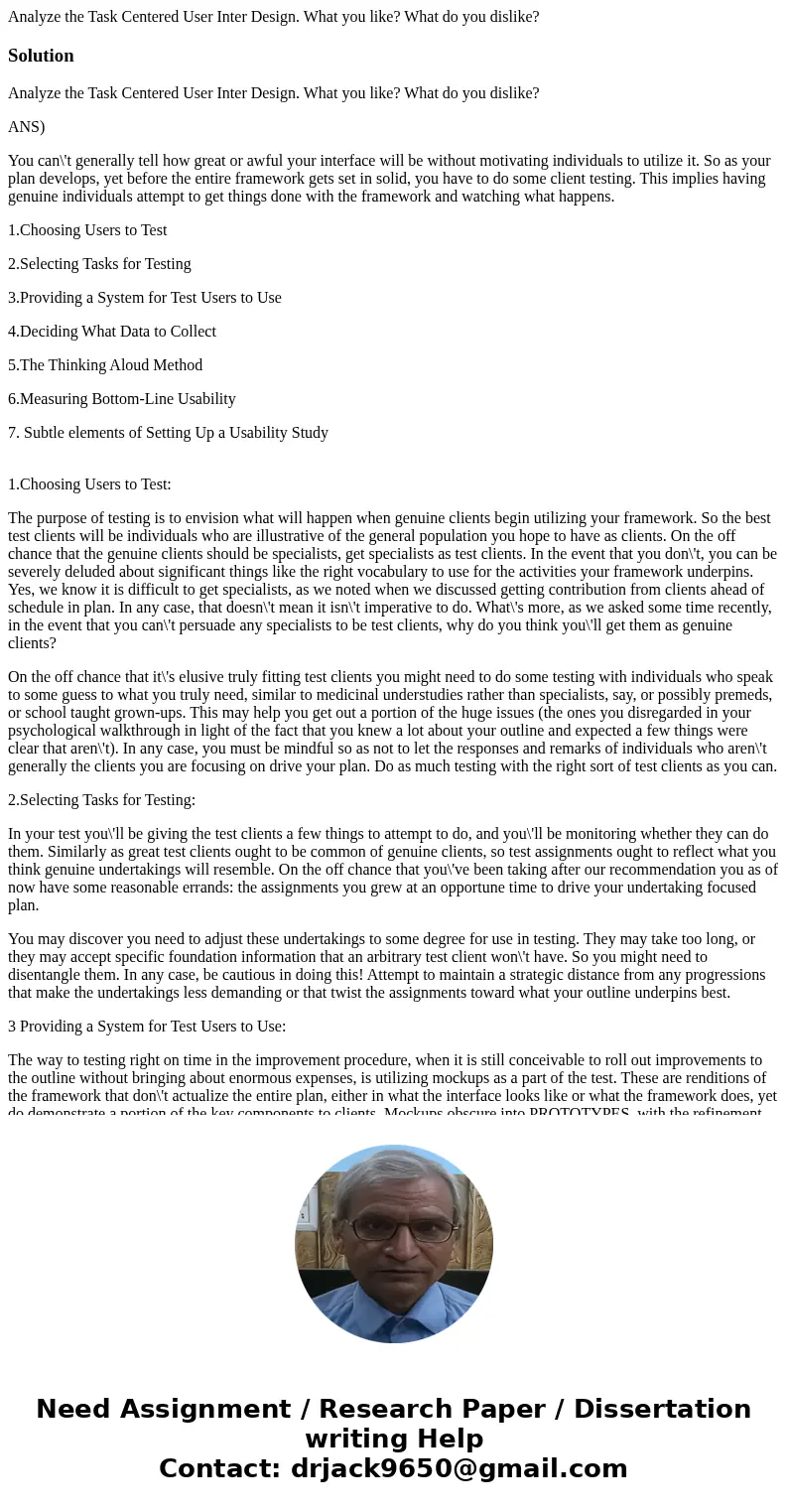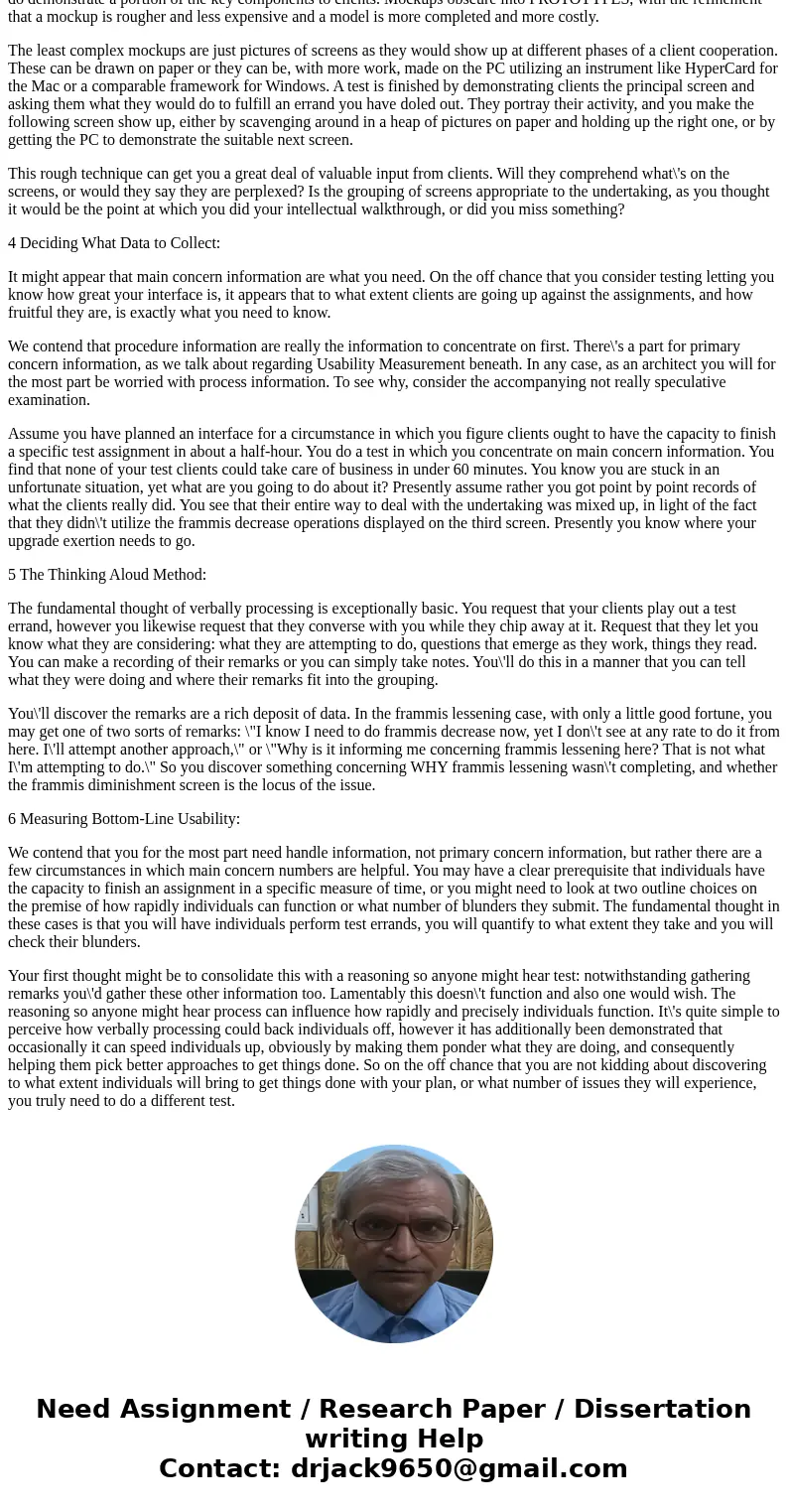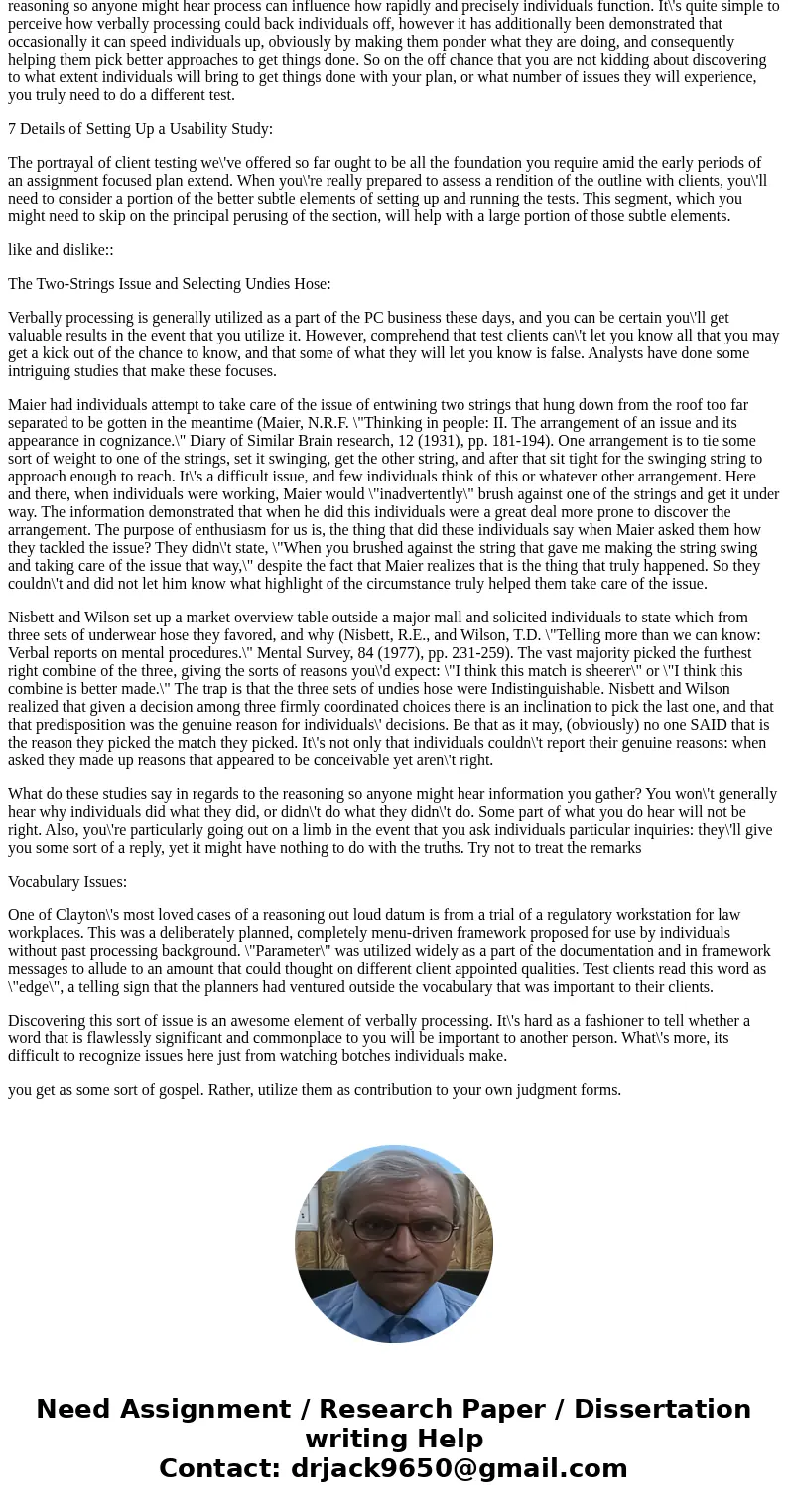Analyze the Task Centered User Inter Design What you like Wh
Analyze the Task Centered User Inter Design. What you like? What do you dislike?
Solution
Analyze the Task Centered User Inter Design. What you like? What do you dislike?
ANS)
You can\'t generally tell how great or awful your interface will be without motivating individuals to utilize it. So as your plan develops, yet before the entire framework gets set in solid, you have to do some client testing. This implies having genuine individuals attempt to get things done with the framework and watching what happens.
1.Choosing Users to Test
2.Selecting Tasks for Testing
3.Providing a System for Test Users to Use
4.Deciding What Data to Collect
5.The Thinking Aloud Method
6.Measuring Bottom-Line Usability
7. Subtle elements of Setting Up a Usability Study
1.Choosing Users to Test:
The purpose of testing is to envision what will happen when genuine clients begin utilizing your framework. So the best test clients will be individuals who are illustrative of the general population you hope to have as clients. On the off chance that the genuine clients should be specialists, get specialists as test clients. In the event that you don\'t, you can be severely deluded about significant things like the right vocabulary to use for the activities your framework underpins. Yes, we know it is difficult to get specialists, as we noted when we discussed getting contribution from clients ahead of schedule in plan. In any case, that doesn\'t mean it isn\'t imperative to do. What\'s more, as we asked some time recently, in the event that you can\'t persuade any specialists to be test clients, why do you think you\'ll get them as genuine clients?
On the off chance that it\'s elusive truly fitting test clients you might need to do some testing with individuals who speak to some guess to what you truly need, similar to medicinal understudies rather than specialists, say, or possibly premeds, or school taught grown-ups. This may help you get out a portion of the huge issues (the ones you disregarded in your psychological walkthrough in light of the fact that you knew a lot about your outline and expected a few things were clear that aren\'t). In any case, you must be mindful so as not to let the responses and remarks of individuals who aren\'t generally the clients you are focusing on drive your plan. Do as much testing with the right sort of test clients as you can.
2.Selecting Tasks for Testing:
In your test you\'ll be giving the test clients a few things to attempt to do, and you\'ll be monitoring whether they can do them. Similarly as great test clients ought to be common of genuine clients, so test assignments ought to reflect what you think genuine undertakings will resemble. On the off chance that you\'ve been taking after our recommendation you as of now have some reasonable errands: the assignments you grew at an opportune time to drive your undertaking focused plan.
You may discover you need to adjust these undertakings to some degree for use in testing. They may take too long, or they may accept specific foundation information that an arbitrary test client won\'t have. So you might need to disentangle them. In any case, be cautious in doing this! Attempt to maintain a strategic distance from any progressions that make the undertakings less demanding or that twist the assignments toward what your outline underpins best.
3 Providing a System for Test Users to Use:
The way to testing right on time in the improvement procedure, when it is still conceivable to roll out improvements to the outline without bringing about enormous expenses, is utilizing mockups as a part of the test. These are renditions of the framework that don\'t actualize the entire plan, either in what the interface looks like or what the framework does, yet do demonstrate a portion of the key components to clients. Mockups obscure into PROTOTYPES, with the refinement that a mockup is rougher and less expensive and a model is more completed and more costly.
The least complex mockups are just pictures of screens as they would show up at different phases of a client cooperation. These can be drawn on paper or they can be, with more work, made on the PC utilizing an instrument like HyperCard for the Mac or a comparable framework for Windows. A test is finished by demonstrating clients the principal screen and asking them what they would do to fulfill an errand you have doled out. They portray their activity, and you make the following screen show up, either by scavenging around in a heap of pictures on paper and holding up the right one, or by getting the PC to demonstrate the suitable next screen.
This rough technique can get you a great deal of valuable input from clients. Will they comprehend what\'s on the screens, or would they say they are perplexed? Is the grouping of screens appropriate to the undertaking, as you thought it would be the point at which you did your intellectual walkthrough, or did you miss something?
4 Deciding What Data to Collect:
It might appear that main concern information are what you need. On the off chance that you consider testing letting you know how great your interface is, it appears that to what extent clients are going up against the assignments, and how fruitful they are, is exactly what you need to know.
We contend that procedure information are really the information to concentrate on first. There\'s a part for primary concern information, as we talk about regarding Usability Measurement beneath. In any case, as an architect you will for the most part be worried with process information. To see why, consider the accompanying not really speculative examination.
Assume you have planned an interface for a circumstance in which you figure clients ought to have the capacity to finish a specific test assignment in about a half-hour. You do a test in which you concentrate on main concern information. You find that none of your test clients could take care of business in under 60 minutes. You know you are stuck in an unfortunate situation, yet what are you going to do about it? Presently assume rather you got point by point records of what the clients really did. You see that their entire way to deal with the undertaking was mixed up, in light of the fact that they didn\'t utilize the frammis decrease operations displayed on the third screen. Presently you know where your upgrade exertion needs to go.
5 The Thinking Aloud Method:
The fundamental thought of verbally processing is exceptionally basic. You request that your clients play out a test errand, however you likewise request that they converse with you while they chip away at it. Request that they let you know what they are considering: what they are attempting to do, questions that emerge as they work, things they read. You can make a recording of their remarks or you can simply take notes. You\'ll do this in a manner that you can tell what they were doing and where their remarks fit into the grouping.
You\'ll discover the remarks are a rich deposit of data. In the frammis lessening case, with only a little good fortune, you may get one of two sorts of remarks: \"I know I need to do frammis decrease now, yet I don\'t see at any rate to do it from here. I\'ll attempt another approach,\" or \"Why is it informing me concerning frammis lessening here? That is not what I\'m attempting to do.\" So you discover something concerning WHY frammis lessening wasn\'t completing, and whether the frammis diminishment screen is the locus of the issue.
6 Measuring Bottom-Line Usability:
We contend that you for the most part need handle information, not primary concern information, but rather there are a few circumstances in which main concern numbers are helpful. You may have a clear prerequisite that individuals have the capacity to finish an assignment in a specific measure of time, or you might need to look at two outline choices on the premise of how rapidly individuals can function or what number of blunders they submit. The fundamental thought in these cases is that you will have individuals perform test errands, you will quantify to what extent they take and you will check their blunders.
Your first thought might be to consolidate this with a reasoning so anyone might hear test: notwithstanding gathering remarks you\'d gather these other information too. Lamentably this doesn\'t function and also one would wish. The reasoning so anyone might hear process can influence how rapidly and precisely individuals function. It\'s quite simple to perceive how verbally processing could back individuals off, however it has additionally been demonstrated that occasionally it can speed individuals up, obviously by making them ponder what they are doing, and consequently helping them pick better approaches to get things done. So on the off chance that you are not kidding about discovering to what extent individuals will bring to get things done with your plan, or what number of issues they will experience, you truly need to do a different test.
7 Details of Setting Up a Usability Study:
The portrayal of client testing we\'ve offered so far ought to be all the foundation you require amid the early periods of an assignment focused plan extend. When you\'re really prepared to assess a rendition of the outline with clients, you\'ll need to consider a portion of the better subtle elements of setting up and running the tests. This segment, which you might need to skip on the principal perusing of the section, will help with a large portion of those subtle elements.
like and dislike::
The Two-Strings Issue and Selecting Undies Hose:
Verbally processing is generally utilized as a part of the PC business these days, and you can be certain you\'ll get valuable results in the event that you utilize it. However, comprehend that test clients can\'t let you know all that you may get a kick out of the chance to know, and that some of what they will let you know is false. Analysts have done some intriguing studies that make these focuses.
Maier had individuals attempt to take care of the issue of entwining two strings that hung down from the roof too far separated to be gotten in the meantime (Maier, N.R.F. \"Thinking in people: II. The arrangement of an issue and its appearance in cognizance.\" Diary of Similar Brain research, 12 (1931), pp. 181-194). One arrangement is to tie some sort of weight to one of the strings, set it swinging, get the other string, and after that sit tight for the swinging string to approach enough to reach. It\'s a difficult issue, and few individuals think of this or whatever other arrangement. Here and there, when individuals were working, Maier would \"inadvertently\" brush against one of the strings and get it under way. The information demonstrated that when he did this individuals were a great deal more prone to discover the arrangement. The purpose of enthusiasm for us is, the thing that did these individuals say when Maier asked them how they tackled the issue? They didn\'t state, \"When you brushed against the string that gave me making the string swing and taking care of the issue that way,\" despite the fact that Maier realizes that is the thing that truly happened. So they couldn\'t and did not let him know what highlight of the circumstance truly helped them take care of the issue.
Nisbett and Wilson set up a market overview table outside a major mall and solicited individuals to state which from three sets of underwear hose they favored, and why (Nisbett, R.E., and Wilson, T.D. \"Telling more than we can know: Verbal reports on mental procedures.\" Mental Survey, 84 (1977), pp. 231-259). The vast majority picked the furthest right combine of the three, giving the sorts of reasons you\'d expect: \"I think this match is sheerer\" or \"I think this combine is better made.\" The trap is that the three sets of undies hose were Indistinguishable. Nisbett and Wilson realized that given a decision among three firmly coordinated choices there is an inclination to pick the last one, and that that predisposition was the genuine reason for individuals\' decisions. Be that as it may, (obviously) no one SAID that is the reason they picked the match they picked. It\'s not only that individuals couldn\'t report their genuine reasons: when asked they made up reasons that appeared to be conceivable yet aren\'t right.
What do these studies say in regards to the reasoning so anyone might hear information you gather? You won\'t generally hear why individuals did what they did, or didn\'t do what they didn\'t do. Some part of what you do hear will not be right. Also, you\'re particularly going out on a limb in the event that you ask individuals particular inquiries: they\'ll give you some sort of a reply, yet it might have nothing to do with the truths. Try not to treat the remarks
Vocabulary Issues:
One of Clayton\'s most loved cases of a reasoning out loud datum is from a trial of a regulatory workstation for law workplaces. This was a deliberately planned, completely menu-driven framework proposed for use by individuals without past processing background. \"Parameter\" was utilized widely as a part of the documentation and in framework messages to allude to an amount that could thought on different client appointed qualities. Test clients read this word as \"edge\", a telling sign that the planners had ventured outside the vocabulary that was important to their clients.
Discovering this sort of issue is an awesome element of verbally processing. It\'s hard as a fashioner to tell whether a word that is flawlessly significant and commonplace to you will be important to another person. What\'s more, its difficult to recognize issues here just from watching botches individuals make.
you get as some sort of gospel. Rather, utilize them as contribution to your own judgment forms.



 Homework Sourse
Homework Sourse